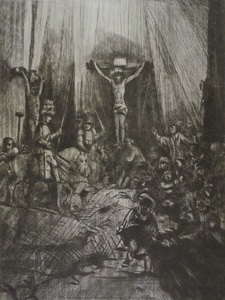| Method | Etching |
| Artist | George Bickham the Younger after Rembrandt |
| Published | [c.1770] |
| Dimensions | Image and plate 344 x 258 mm, Sheet 347 x 261 mm |
| Notes |
Based on the central section of the final and fifth state of Rembrandt's 1653 etching 'The Three Crosses'. Just as with Rembrandt's etching in which five states were created, Bickham produced various states based on those of Rembrandt's. In this particular state, the horse is facing in the opposite direction, the surrounding figures are monumentally darker, and various figures have in fact been completely removed towards the foreground. The composition places Christ on the cross in the centre, with the two thieves, also being crucified, to the sides. Whilst the cross to the left is visible, that to the right is almost completely concealed by darkness. Whilst in earlier states, the mourning Virgin was clearly defined, here, she is almost indistinguishable, also greatly hidden by the intense darkness to the right of the composition. Inscription running along bottom of image reads: 'The two Crosses first thought by Rembrandt, this by Bickham'. Where the plate has been reworked, the inscription has been hatched over, and is particularly difficult to decipher. Although based on Rembrandt's 'The Three Crosses', Bickham's execution is incomparable to the source. The figures, in particular, are strangely elongated and disproportionate. George Bickham the Younger (c.1706 - 1771) was a British printmaker and prolific publisher. He published a variety of material, with his first major publication being a series of engraved song sheets entitled 'The Musical Entertainer'. Although several of the prints that Bickham published appear to have been engraved and etched by him, he signed the works with pseudonyms. Condition: Trimmed close to plate mark. |
| Framing | unmounted |
| Price | £200.00 |
| Stock ID | 40595 |

